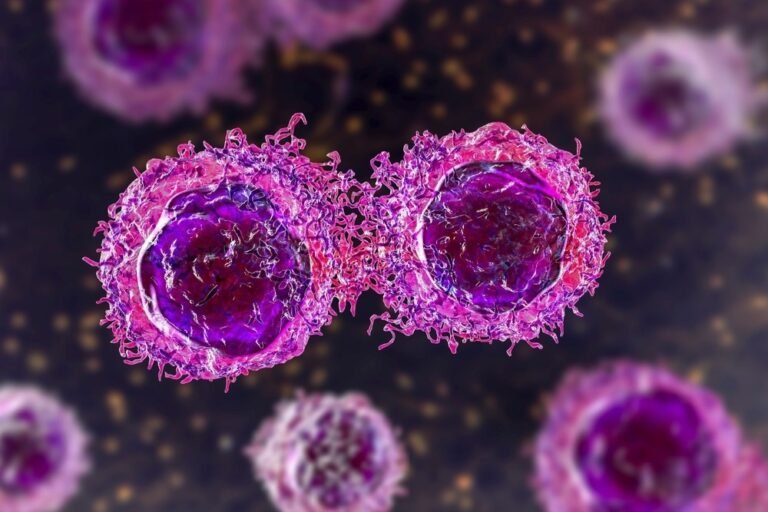A protein whose function is normally to determine the growth of the prostate tells the cells to keep growing in the cancer.
In a recent study published in Genetics of Natureresearchers investigated the involvement of the androgen receptor (AR) in the development and progression of prostate cancer (PCa).
Background
AR is primarily responsible for prostate cancer, which is the most common cancer among men in North America. AR regulates prostate growth in normal cells but promotes tumor growth in PCa. AR activity is altered in prostate cancer, resulting in AR dependence for tumor growth and survival, especially in metastatic castration-resistant PCa (mCRPC). AR is the primary target of treatment after surgery or radiation. Investigating androgen receptor chromatin dynamics and cofactors could contribute to new drug development efforts.
About the study
The present study investigated the molecular processes behind AR activity and its implications for therapeutic approaches in mCRPC.
The researchers used Clustered Regularly Interspaced Short Palindromic Repeats (CRISPR)-associated protein 9 (Cas9) to create an endogenous AR reporter system. CRISPR screening revealed cofactors involved in androgen receptors and prostate cancer. They took the enhanceosome, a complex of many proteins, including transcription and other epigenetic factors, that assemble on deoxyribonucleic acid (DNA) at precise spots to stimulate gene expression. They contrast these with the neo-enhancer.
The researchers explored several approaches to reduce or eliminate the expression of nuclear receptor SET domain-binding protein 2 (NSD-2) in prostate cancer cells. They used gene knockout to transduce cells using single guide ribonucleic acids (sgRNA) targeting NSD-1 and NSD-2. They altered the KLK3 gene in AR-induced lymph node cell carcinoma of the prostate (LNCaP) to insert the mCherry coding sequence, which was then fused in-frame to the kallikrein-related peptidase 3 (KLK3) gene using an endopeptidase sequence .
Cells were transfected with gene-targeting ON-TARGETplus SMARTpool siRNAs (or ASOs) followed by treatment with EPZ-6438 for 72 hours. They investigated whether EPZ-6438, a selective inhibitor of the histone methyltransferase EZH2, could inhibit tumor growth.
The researchers phenotypically evaluated NSD2-deficient PCa cells and produced LLC0150, a chemical that inhibits NSD-1 and NSD-2. Total RNA and protein levels revealed that the target genes were efficiently knocked down (over 80%). The Bliss approach determined synergy between pharmacological treatments. The CRISPR screen identified AR binding to chromatin and chimeric AR hemi-patterns.
The researchers used NOD SCID mice and prostate cancer patient samples from the University of Michigan archives. They also used vertebral prostate cancer (VCaP), human embryonic kidney 293 cells (HEK293FT), LNCaP, and 22RV1-competent cell culture experiments. The researchers compared mycoplasma genotyping and cell line findings with short repeat sequence profiles from the American Type Culture Collection (ATCC) database.
They performed proliferation assays, Matrigel invasion assays, quantitative polymerase chain reaction (PCR), gene set enrichment analysis, and immunofluorescence. Assessments included chromatin immunoprecipitation sequencing (ChIP-seq) and HOMER motif identification.
Results
The researchers found that NSD-2 alters the action of AR, a critical regulator of proper prostate growth. When AR binds to NSD2, it promotes rapid cell division and growth, resulting in prostate cancer. NSD-2 is a critical component of AR enhancer complexes in prostate cancer cells, suggesting that NSD-2 is a therapeutic target for mCRPC. AR acts as a transcription factor, activating genes that drive the differentiation of luminal epithelial cells.
NSD-2 is an AR coactivator that is overexpressed in altered prostatic luminal epithelial cells. The transcriptional activity of the AR complex is dependent on methyltransferase function. Inactivation of NSD-2 impairs AR binding in more than 65.0% of its tumor cisterna, reducing cancer hallmarks. NSD-2-dependent AR sites contain the chimeric forkhead box protein A1 (FOXA1):androgen receptor motif, which includes tumor-specific androgen receptor enhancer circuits. NSD-2 functions as a histone methyltransferase, protecting chromatin from repressive marks and promoting gene expression.
Knockdown of NSD-2 inhibits cancer growth, but does not eliminate it. NSD-1 and NSD-2 enable AR oncogenic activity separately, with NSD-2 acting as a molecular switch to activate cancer hallmarks. Loss of NSD-2 enhances NSD-1 dependence in AR-dependent PCa cells, making aberrant NSD1/2 targetable hotspots. LLC0150, which degrades NSD-1 and NSD-2, showed selective efficacy in androgen receptor-dependent and NSD-2-modified cancer cells.
Compounds that degrade NSD-1 and NSD-2 eliminated prostate cancer cell lines. The degradants only targeted cancer cells, without causing damage to normal cells. However, further research is needed to improve the degrader, as the initial version could not be transferred to a mouse model. Data suggest that drugs targeting NSD-1 or NSD-2 may be used with AR antagonists to achieve synergistic benefits in the treatment of prostate cancer.
Conclusion
Based on the study findings, prostate cancer cells depend on androgen receptors for progression, with AR activity significantly reprogrammed in malignant stages. Production of neo-enhancers and expansion of the androgen receptor enhancer circuit are essential for the establishment and maintenance of aggressive PCa phenotypes.
The finding of NSD-2 as a component of AR enhancer complexes implies new pathways for therapeutic targeting in mCRPC. The findings highlight the necessity of knowledge of the involvement of AR and related factors in the development of effective PCa therapies.
